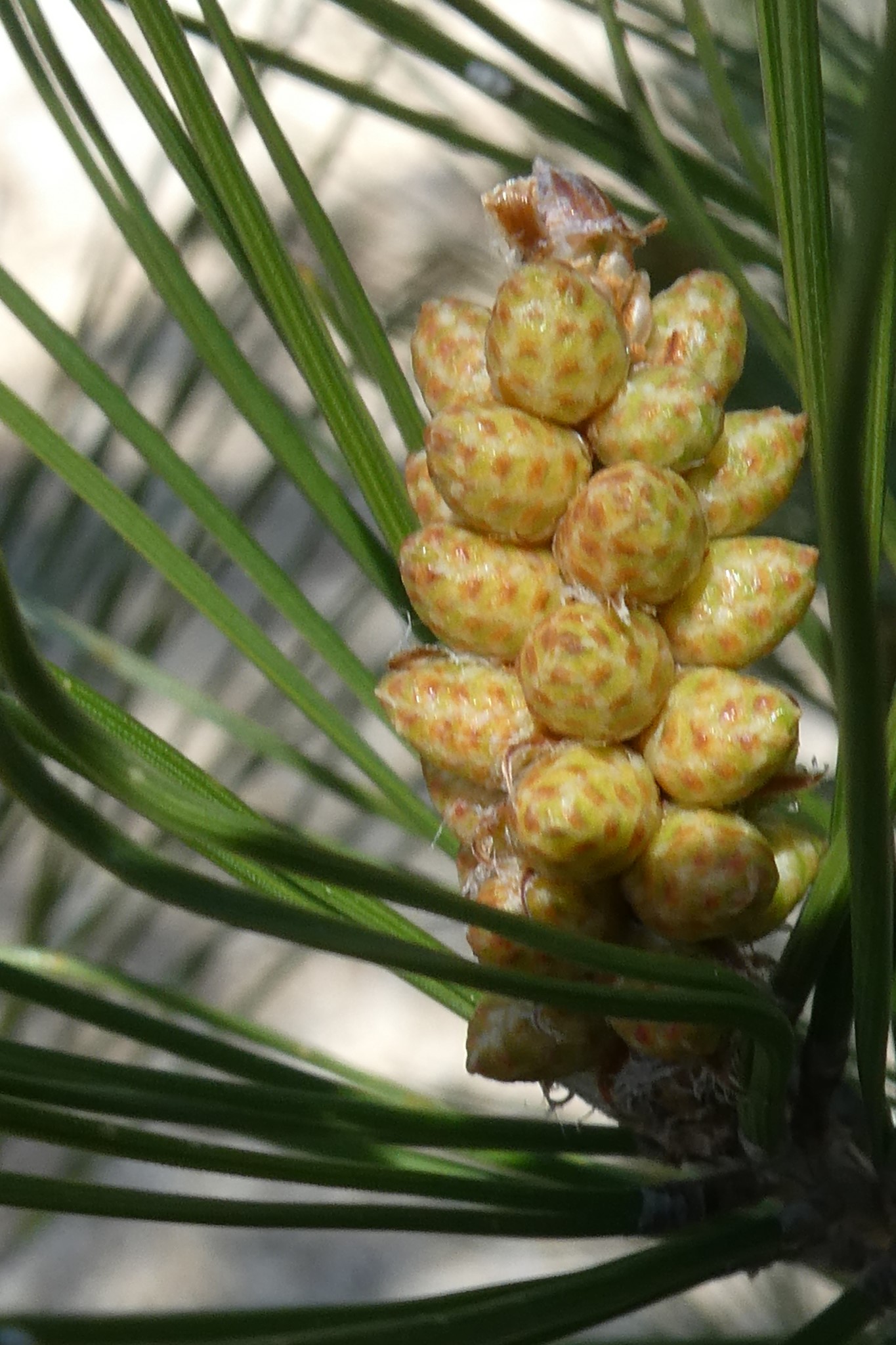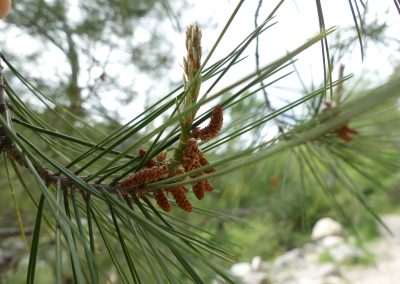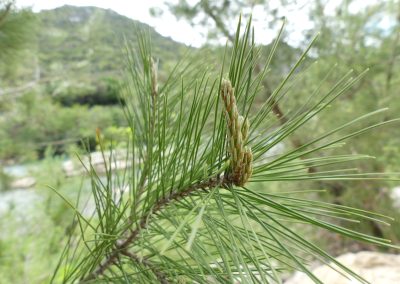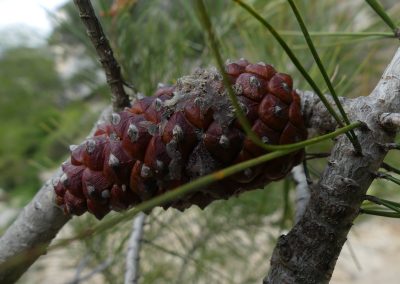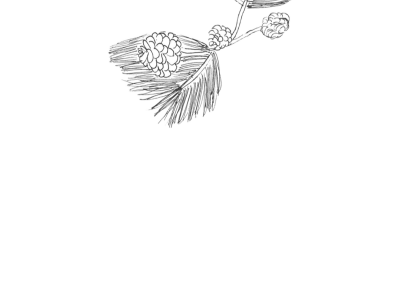Pinus halepensis
Scientific description
Taxon: Pinus halepensis
Class: Pinopsida
Subclass: Pinidae
Order: Pinales
Family: Pinaceae
Common name: Aleppo pine
Origin:
Mediterranean basin (Southern Europe, North Africa, Middle East).
Description:
Resinous conifer with persistent foliage, 15–20 m tall. Irregular slender habit, gray to reddish-brown cracked bark. Needles thin, flexible, light green to gray-green, in pairs. Ovoid cones light brown, remain several years, release seeds after thermal stress (pyrochorous). Tolerates heat, poor/calcareous/siliceous soils, prolonged drought. Colonizes abandoned or burned lands.
Propagation:
Mainly by seeds, often after fire (serotinous). Reforestation by direct sowing or planting.
Ecology:
Pioneer species in maquis and garrigue. Stabilizes soils, improves degraded land, feeds birds and small mammals.
Uses:
Forestry, reforestation, soil stabilization. Wood for light carpentry and paper industry. Resin historically used (e.g., Greek retsina).
Threats:
Not globally threatened, but vulnerable to massive fires and urban pressure. Can promote fire spread if unmanaged.
Taxon: Pinus halepensis
Classe: Pinopsida
Sous-classe: Pinidae
Ordre: Pinales
Famille: Pinacées
Nom commun: Pin d’Alep
Origine:
Bassin méditerranéen (Europe du Sud, Afrique du Nord, Moyen-Orient).
Description:
Conifère résineux persistant, 15–20 m. Port irrégulier, souvent élancé, écorce gris à brun-rougeâtre. Aiguilles fines, souples, vert clair à gris-vert, par paires. Cônes ovoïdes persistants, libèrent graines après stress thermique. Tolère chaleur, sols pauvres/calcaires/siliceux, sécheresse prolongée. Colonise terrains abandonnés ou incendiés.
Propagation:
Principalement par graines, souvent après incendie (graines sérotines). Reboisement par semis direct ou plantation.
Écologie:
Espèce pionnière du maquis et garrigue. Fixe sols, améliore terrains dégradés, nourrit oiseaux et petits mammifères.
Utilisation:
Sylviculture, reboisement, stabilisation des sols. Bois pour menuiserie légère et papeterie. Résine historiquement utilisée (retsina grecque).
Menace:
Non menacée globalement, vulnérable aux incendies massifs et pression urbaine. Favorise propagation du feu si non gérée.
Taxon: Pinus halepensis
Clasă: Pinopsida
Subclasă: Pinidae
Ordin: Pinales
Familie: Pinaceae
Denumire populară: Pinul de Alep
Origine:
Bazinul mediteranean (Europa de Sud, Africa de Nord, Orientul Mijlociu).
Descriere:
Conifer rășinos, frunziș persistent, 15–20 m. Formă neregulată, zveltă, scoarță gri–brun-roșiatică. Ace subțiri, flexibile, verde deschis–verde-gri, câte două. Conuri ovoidale persistente, eliberează semințe după stres termic. Tolerant la căldură, soluri sărace/calcaroase/silicioase, secetă prelungită. Colonizează terenuri abandonate sau arse.
Propagare:
Prin semințe, adesea după incendii (semințe serotinice). Reîmpăduriri prin semănat direct sau plantare.
Ecologie:
Specie pionieră în maquis și garrigue. Stabilizează soluri, îmbunătățește teren degradat, hrănește păsări și mamifere mici.
Utilizare:
Silvicultură, reîmpădurire, stabilizare sol. Lemn pentru tâmplărie ușoară și hârtie. Rășină folosită istoric (retsina grecească).
Amenințări:
Nu este amenințat global, dar vulnerabil la incendii masive și presiune urbană. Poate favoriza răspândirea focului dacă nu e gestionat.
Ταξινόμηση: Pinus halepensis
Κλάση: Pinopsida
Υποκλάση: Pinidae
Τάξη: Pinales
Οικογένεια: Pinaceae
Κοινή ονομασία: Πεύκο της Αλεπόπετρας (Πεύκο του Άλεπο)
Προέλευση:
Μεσογειακή λεκάνη (Νότια Ευρώπη, Βόρεια Αφρική, Μέση Ανατολή).
Περιγραφή:
Ρητινώδης κωνοφόρος, αειθαλής, 15–20 μ. Ακανόνιστος λεπτός σχήμα, φλοιός γκρι έως κοκκινωπός ραγισμένος. Βελόνες λεπτές, ευέλικτες, ανοιχτοπράσινες–γκριζοπράσινες, σε ζεύγη. Κώνοι ωοειδείς, παραμένουν χρόνια, απελευθερώνουν σπόρους μετά θερμικό στρες. Ανθεκτικό στη ζέστη, φτωχά/ασβεστολιθικά/πυριτικά εδάφη, ξηρασία. Αποικίζει εγκαταλελειμμένες ή καμένες εκτάσεις.
Διάδοση:
Κυρίως με σπόρους, συχνά μετά φωτιά (σεροτινικοί σπόροι). Αναδασώσεις με σπορά ή φύτευση.
Οικολογία:
Είδος πρωτοπόρο σε μακί και γαρυγιές. Σταθεροποιεί εδάφη, βελτιώνει υποβαθμισμένα εδάφη, τρέφει πουλιά και μικρά θηλαστικά.
Χρήσεις:
Δασοκομία, αναδασώσεις, σταθεροποίηση εδαφών. Ξύλο για ξυλουργική και χαρτοβιομηχανία. Ρητίνη ιστορική χρήση (ρετσίνα).
Απειλές:
Δεν απειλείται παγκοσμίως, αλλά ευάλωτο σε μαζικές πυρκαγιές και αστική πίεση. Μπορεί να ευνοήσει εξάπλωση φωτιάς αν δεν διαχειριστεί.
Creative writing inspired by Pinus halepensis
The Aleppo Pine
Once upon a time, in a forest by the sea in Marseille, there lived an Aleppo pine. It had a secret it didn't want anyone to know. That it could easily catch fire and spread to the rest of the area. But it wasn't something it wanted, it didn't want to hurt anyone, it was just its nature.
One summer morning, a careless driver threw his cigarette into the woods and the pine started to catch fire. Its fruits, the pinecones, began to open up and pop out here and there, spreading terror everywhere. And while all the animals of the forest used to shelter under its shade, they all moved away from it, because they thought it was the pine who had caused the fire.
The pine, sad and pained in its solitude, began to weep, and its tears became raindrops that watered nature and extinguished the fire. All the animals in the forest are stunned by this sight and approach the pine to observe.
And that's what it tells them: ‘’It's not my fault I'm flammable, I was born that way. But I'm not the one who starts fires. If people are careless and create fires, it's not our fault that we plants catch fire easily.’’ The animals understand that it's not the pine's fault and organize dances around it. From then on, they protect it, and when they perceive a risk of fire, they run in search of the culprit or use their cries to warn other animals to move away. And the pine rises in rain clouds over all plants and trees to always protect them.


